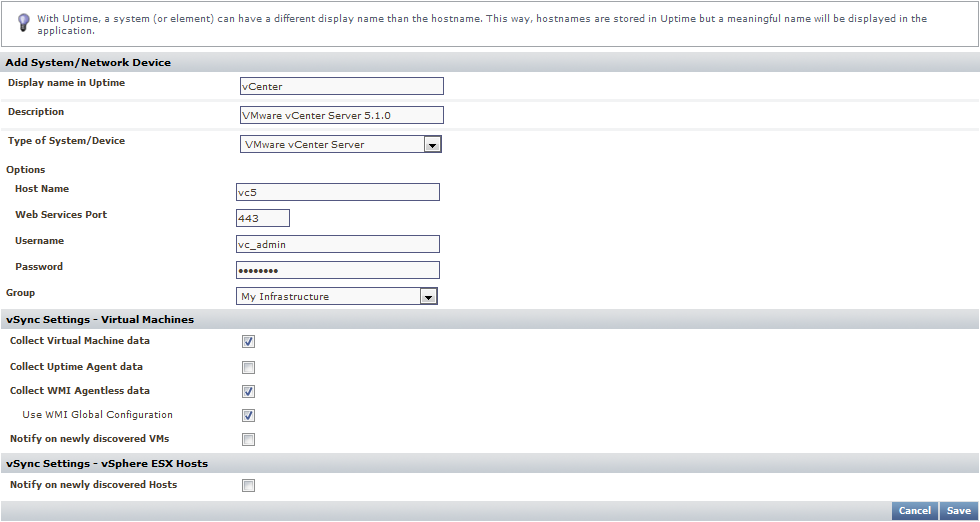...
- In the up.time Web interface, begin by clicking My Infrastructure.
- Begin adding your VMware vCenter Server as an up.time Element. In the My Infrastructure view, click Add System/Network Device.
- In the Add System window, select VMware vCenter Server from the Type of System/Device drop-down. This reveals configuration fields specific to this type of monitored Element.
- Complete the fields similar to those below:
- The Display Name is used throughout the up.time interface, as well as reports.
- The Description can contain any extra information such as the version number or IP address.
- The Options fields tell up.time how to find and access your vCenter Server.
- You can leave the vSync Settings options at their defaults.
Note title Stick to the Basics By default, the Collect up.time Agent data and Collect WMI Agentless data check boxes are clear. This means the metrics up.time retrieves for each monitored VM is what the vCenter Server itself collects and provides to up.time. For these "basic VMs," , their metrics are a subset of what can be collected from the guest operating system using the up.time agent or using WMI. For simplicity in this guide, we will work with a "basic" vCenter Server inventory. You can learn more about agent- and WMI-based data collection in the next module, where you are adding physical servers.
- Click Save. up.time will search for your vCenter Server and import its inventory of ESX hosts and VMs as up.time Elements. This can take a minute or more, depending on how large your vCenter inventory is.
- up.time will inform you when the vCenter Server has been added:
Click Done to close the Add System window.
...
| Note | ||
|---|---|---|
| ||
In this module, if the inventory imported from vCenter Server exceeds open slots in your license, some of the inventory will have been ignored, and you will have no space left to add Elements to your monitored inventory. In the next two tracks In this Getting Started Guide, you will be adding servers and network devices. If you plan on following either or both of these tracks, you need to anticipate the number of servers and network devices you will add. To follow the server track, you'll need at least 2; to follow the network device track, you'll need at least 1. The easiest way to free up space is to manually ignore VMs; each VM you ignore opens a license spot for a new Element. Return to the Inventory Detail view for the vCenter (My Infrastructure > gear icon > View > Inventory Detail). Select VMs, ESX hosts, or even an entire cluster, then click Add Selected Elements to Ignore. That number of spots will be freed up in your license, which you can verify by clicking Config > License Info. Alternatively, you can also contact uptime software up.time Customer Support to look into increasing the size of your license. |
...
| Section | ||||||||||
|---|---|---|---|---|---|---|---|---|---|---|
| ||||||||||
|


